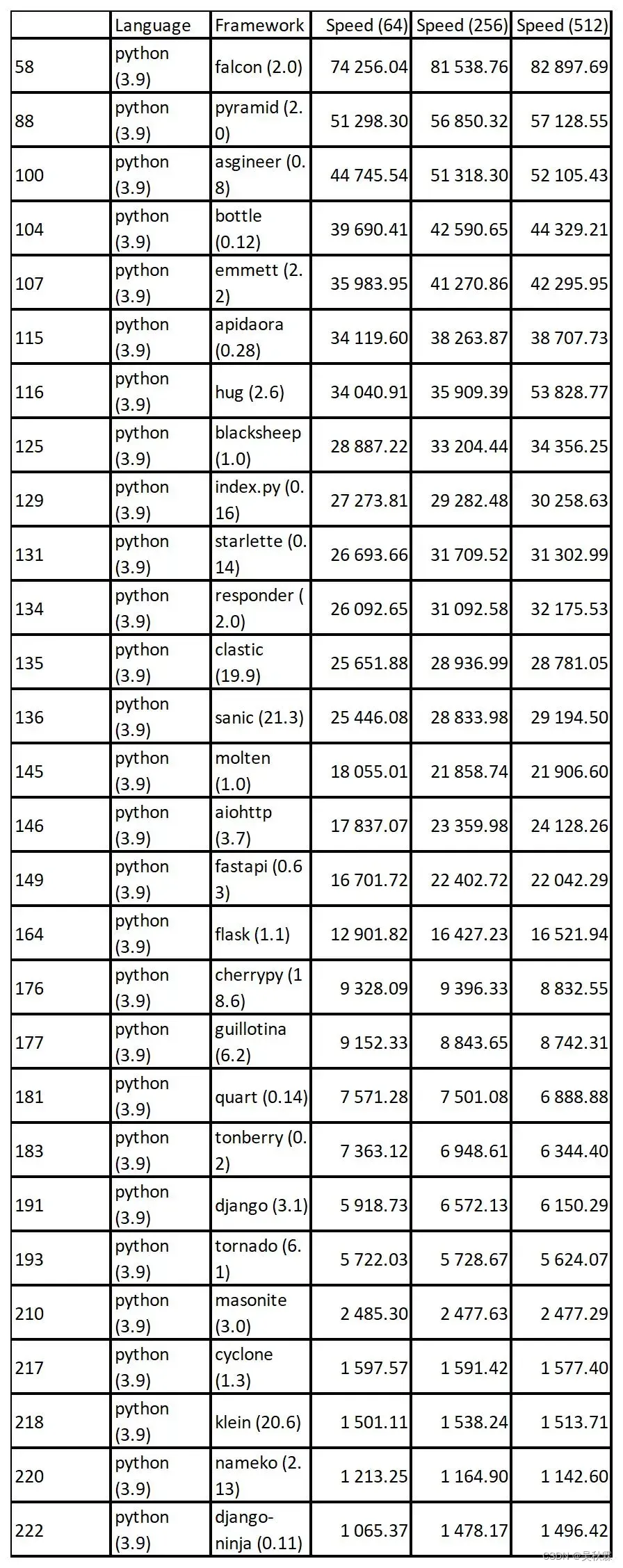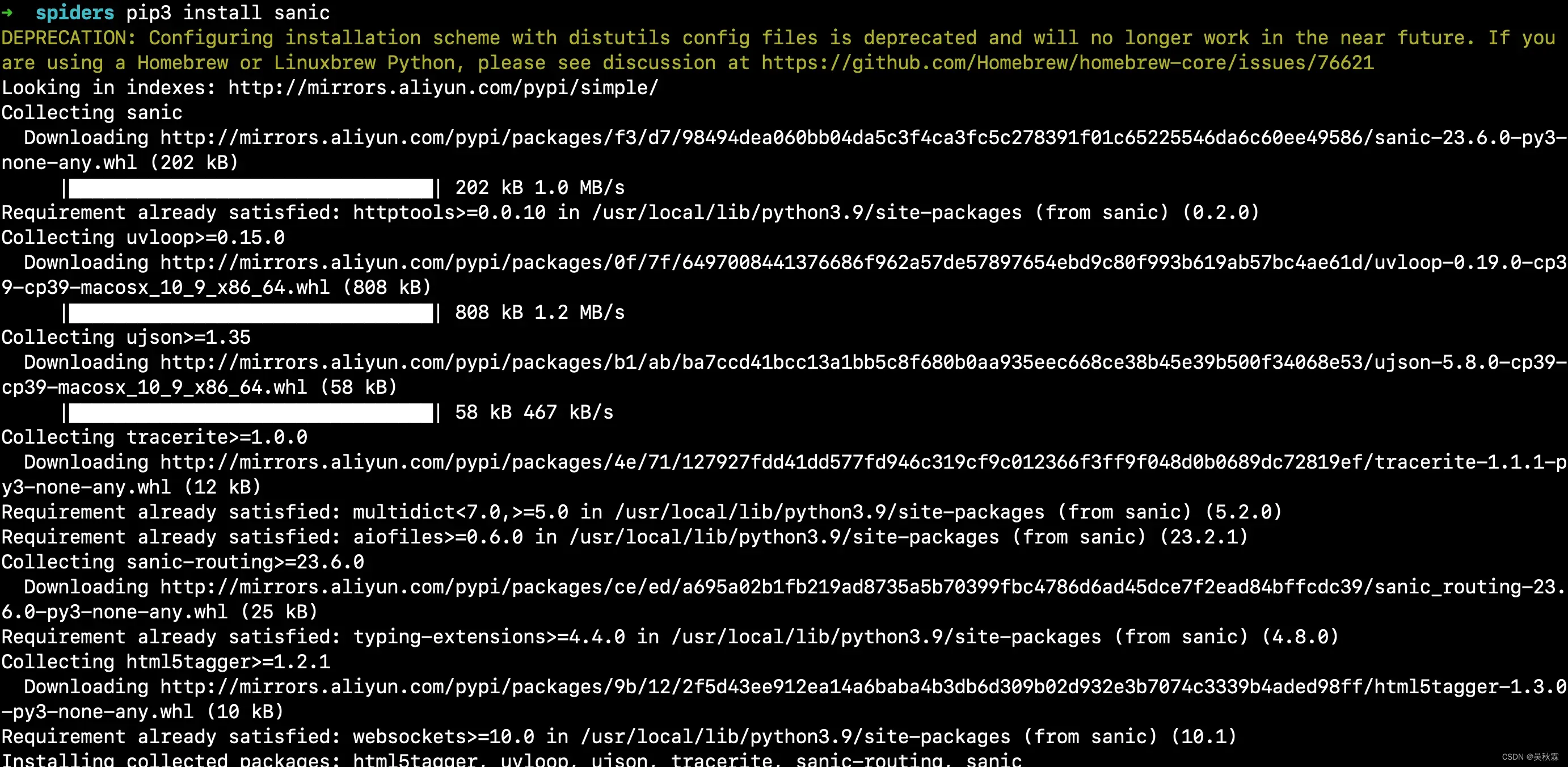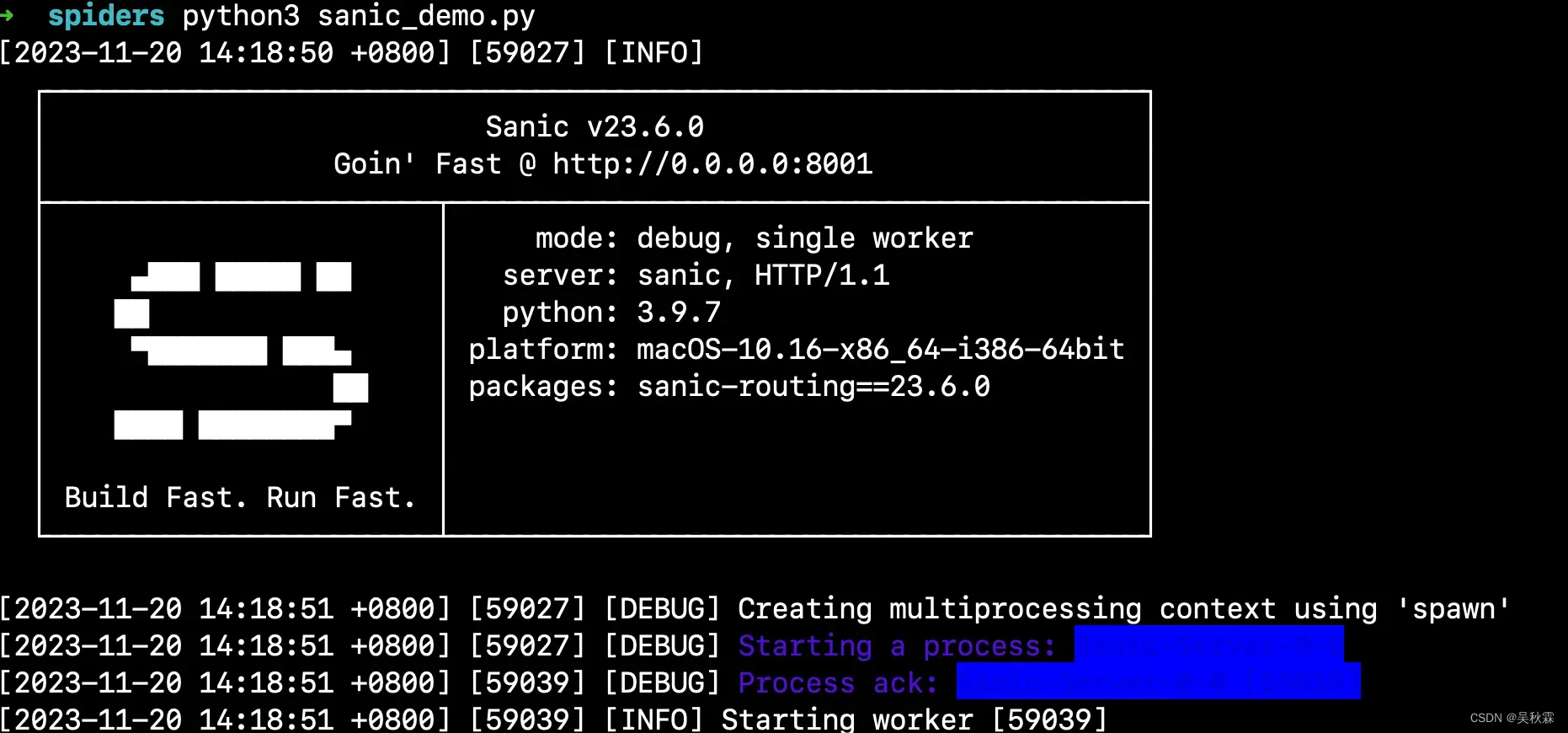文章目录
- 1. 写在前面
- 2. Sanic框架简介
- 2.1 背景
- 2.2 特征与优势
- 3. Sanic框架实战
- 3.1. 安装Sanic
- 3.2. Demo案例编写
【作者主页】:吴秋霖
【作者介绍】:Python领域优质创作者、阿里云博客专家、华为云享专家。长期致力于Python与爬虫领域研究与开发工作!
【作者推荐】:对JS逆向感兴趣的朋友可以关注《爬虫JS逆向实战》,对分布式爬虫平台感兴趣的朋友可以关注《分布式爬虫平台搭建与开发实战》
还有未来会持续更新的验证码突防、APP逆向、Python领域等一系列文章
1. 写在前面
在Python的Web开发领域内这些年框架也是层出不穷,早已不再局限于Django、Flask、Tornado甚至是后面的FastApi
曾经的玄冥二老也慢慢退居幕后,新的时代都是年轻人天下!这个时代的年轻王者无疑是Sanic
在网上有对Python所有的Web框架做过测试,可以看到曾经的老牌框架已经垫底:

官方地址:Sanic
从Python3+后,各种异步很火,所以说相对于传统的同步框架在某些特定的场景下更加适应,因为同步与异步在并发、实时性上还是有很大差异的
2. Sanic框架简介
2.1 背景
Sanic最早由ChannelCat团队开发,旨在提供一个高性能的异步Web框架。其灵感来自于Flask,并在异步编程的基础上进行了优化。Sanic利用Python3.5引入的async/await语法,使得开发者可以编写快速且高效的异步Web应用程序
2.2 特征与优势
江湖中的朋友们一直都称之为Python史上最强且最快的Web框架,并且流行度越来越广泛
- 高性能:利用异步编程的优势,允许处理大量并发请求而不会阻塞线程,从而实现高性能和低延迟
- 轻量级:核心设计非常简洁,不依赖大量的外部库,使得其体积小巧,易于部署和维护
- 路由功能:提供了简单易用的路由功能,让开发者能够轻松地定义URL和处理请求的处理程序
- 中间件支持:支持中间件,开发者可以在请求和响应处理过程中添加额外的逻辑
- WebSocket支持:对WebSocket 提供了良好的支持,允许构建实时的双向通信应用程序
3. Sanic框架实战
3.1. 安装Sanic
首先我们使用pip命令安装Sonic:
pip3 install sanic

3.2. Demo案例编写
如下是一个简单的Sanic应用程序,实现了基本的路由与请求:
# -*- coding: utf-8 -*-
from sanic import Sanic
from sanic import response
app = Sanic("sanic_demo")
@app.route("/")
def run(request):
return response.text("Hello World !")
if __name__ == '__main__':
app.run(host="0.0.0.0", port=8001, debug=True)
在终端中运行上面应用程序:

程序运行后我们在浏览器地址中访问http://127.0.0.1:8001就可以看到返回的信息了
接下来我们编写一个稍微复杂的案例代码,这是一个简化的在线商店系统,包括用户注册、商品管理、购物车等功能。实际真实的商城会更加复杂
# -*- coding: utf-8 -*-
from sanic import Sanic, response
from sanic.exceptions import NotFound, ServerError
from sanic_jwt import Initialize, protected
from sanic_session import Session, InMemorySessionInterface
app = Sanic("OnlineStore")
app.config.SECRET_KEY = "supersecretkey"
Initialize(app, authenticate=None)
Session(app, interface=InMemorySessionInterface())
users_db = {}
products_db = {}
carts_db = {}
# Routes
@app.route("/")
async def home(request):
return response.text("欢迎来到爬虫商店!")
@app.route("/register", methods=["POST"])
async def register(request):
data = request.json
username = data.get("username")
password = data.get("password")
if username in users_db:
return response.json({"message": "Username already exists"}, status=400)
users_db[username] = password
return response.json({"message": "Registration successful"})
@app.route("/login", methods=["POST"])
async def login(request):
data = request.json
username = data.get("username")
password = data.get("password")
if username not in users_db or users_db[username] != password:
return response.json({"message": "Invalid credentials"}, status=401)
token = app.auth.jwt_encode(request, {"username": username})
return response.json({"token": token})
@app.route("/products", methods=["GET"])
@protected()
async def get_products(request):
return response.json({"products": products_db})
@app.route("/add_to_cart", methods=["POST"])
@protected()
async def add_to_cart(request):
data = request.json
username = request.ctx.get("user").get("username")
product_id = data.get("product_id")
quantity = data.get("quantity", 1)
if product_id not in products_db:
return response.json({"message": "Product not found"}, status=404)
if username not in carts_db:
carts_db[username] = {}
if product_id not in carts_db[username]:
carts_db[username][product_id] = quantity
else:
carts_db[username][product_id] += quantity
return response.json({"message": "Product added to cart"})
@app.route("/view_cart", methods=["GET"])
@protected()
async def view_cart(request):
username = request.ctx.get("user").get("username")
if username not in carts_db:
return response.json({"cart": {}}, status=200)
return response.json({"cart": carts_db[username]})
# Error Handlers
@app.exception(NotFound)
async def not_found(request, exception):
return response.json({"message": "Not Found"}, status=404)
@app.exception(ServerError)
async def server_error(request, exception):
return response.json({"message": "Internal Server Error"}, status=500)
if __name__ == "__main__":
app.run(host="0.0.0.0", port=8000, debug=True)
在上面的代码中使用了Sanic框架处理用户注册、登录、商品管理、购物车等功能。同时,使用了Sanic JWT进行用户身份验证和会话管理
最后总结一下:
Sanic适用于需要高性能、实时性的应用,以及小型到中型项目
Django适用于大型、全功能的Web应用程序,尤其是需要使用内置功能快速构建应用的场景
Flask适用于对框架提供的功能有更大灵活性和控制需求,以及对轻量级框架的偏好
好了,到这里又到了跟大家说再见的时候了。创作不易,帮忙点个赞再走吧。你的支持是我创作的动力,希望能带给大家更多优质的文章
文章出处登录后可见!
